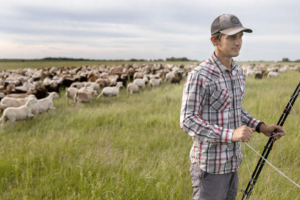The median age rose in almost every state last year, census estimates show, continuing a long-term trend that is pushing states to prepare for aging populations.
Seventeen states had median ages over 40 in 2022, according to new U.S. Census Bureau estimates of the age at which half of residents are older and half are younger. That’s up from 12 states in 2020 and just seven in 2010.
Nationwide, the median age was below 30 until 1980, but it rose to 38.9 as of 2022, according to the bureau estimates.
That leaves more states planning for future health and housing challenges for older residents. Some states have issued or are considering executive orders, agency plans and legislation to assist state residents who need more help with health crises, housing and long-term care as they live longer.
Millennials started turning 40 last year, and the youngest baby boomers are quickly approaching 60.
“As the nation’s median age creeps closer to 40, you can really see how the aging of baby boomers, and now their children — sometimes called echo boomers — is impacting the median age,” said Kristie Wilder, a Census Bureau demographer, in a statement.
Lower birth rates also play a role and will likely continue to drive median age slowly but steadily higher, Wilder added. Some states have passed legislation requiring that health insurers cover fertility treatments in response to lower fertility rates, according to a University of California, Irvine study published last year. New York state’s 2020 law, for example, requires coverage of in vitro fertilization in some cases.
No states saw a drop from 2021 to 2022, and states with unchanged medians were Alabama, Maine, Tennessee and West Virginia, along with the District of Columbia. The largest increase in median age in recent years was in Delaware, where it rose three years since 2010 to age 41.8.
The portion of Delaware residents over 60 will jump from a quarter to more than a third of the state population by 2040, according to a 2020 state report, creating new challenges for state services. A Delaware Journal of Public Health report published in 2021 said a growing number of Delaware’s older residents suffer from dementia, requiring more expensive help from the state and family caregivers.
Vermont held six public listening sessions around the state last year to help prepare recommendations this year for Age Strong Vermont, its road map for an “age-friendly state.”
“Vermont had this older demographic for a long time but it’s taken a while for the state broadly to really reckon with that,” said Angela Smith-Dieng, Vermont’s Adult Services Division director. Part of the challenge is that older Vermont residents tend to live in big rural houses and need help with in-home health care, renovations for mobility and transportation on demand, she said.
A New York executive order in November also calls for a statewide plan on aging.
Vermont and New York joined other states already planning comprehensive strategies for aging populations: California, Colorado, Massachusetts and Texas, according to a January report by the National Conference of State Legislatures.
California’s Master Plan for Aging, released in 2021, aims to create an “age-friendly California” by 2030, including housing and health care strategies. A bill currently progressing in the state legislature would create a statewide system of respite providers by 2025 to help give primary caregivers of older adults enrolled in Medi-Cal, the state's Medicaid program for low-income residents, a break.
Elsewhere, an Oregon bill to study long-term care needs for older residents has passed both chambers of the legislature.
Only North Dakota is younger now than it was in 2010, down 1.2 years from age 37 to 35.8. The state’s burgeoning oil industry has drawn younger workers to jobs that pay well and don’t require four-year college degrees.
Energy counties in other states have seen similar influxes of young people. Loving County, Texas, for example, saw its median age decrease from 52.7 in 2010 to 35.3 in 2022, a difference of more than 17 years.
Skeet Lee Jones, county judge there, said the tiny county has work camps for more than 1,000 oil workers and hundreds more young workers living in recreational vehicle camps, with good-paying jobs that create their own challenges for county government.
“We’ve had to start paying our own county workers what we call ‘oil-field wages’ just to get things done, about four or five times minimum wage,” Jones said.
The oldest state in the country remains Maine at 44.8. It also was the oldest in 2010, at 42.7.
Other states with median ages at 40 or above in 2022: New Hampshire (43.3), Vermont (43.2), West Virginia (42.8), Florida (42.7), Delaware (41.8), Pennsylvania and Connecticut (40.9), Hawaii (40.7), Rhode Island (40.6), Wisconsin (40.4), New Jersey, Oregon and South Carolina (all 40.3), Montana and Michigan (40.2), and Massachusetts (40.1).
The youngest states and the only ones with median ages below 37 were Utah (31.9), the District of Columbia (34.8), Texas (35.5), and Alaska and North Dakota (35.8)
On the county level, the median age in 2022 was as low as 20.9 in Madison County, Idaho, home of Brigham Young University-Idaho, where many young students are also starting families.
The median age was as high as 68.1 in Sumter County, Florida, part of the sprawling The Villages retirement community. In 2010 Sumter County’s median age was 62.7, the only county with a median age of 60 or higher in the nation at the time.
In 2022 there were six others: Catron County, New Mexico (62.1); Jeff Davis County, Texas (61.7); Harding County, New Mexico (60.5); Jefferson County, Washington (60.4); Charlotte County, Florida (60.2); and Highland County, Virginia (60.0).
Stateline is part of States Newsroom, a network of news bureaus supported by grants and a coalition of donors as a 501c(3) public charity. Stateline maintains editorial independence. Contact Editor Scott Greenberger for questions: [email protected]. Follow Stateline on Facebook and Twitter.
Our stories may be republished online or in print under Creative Commons license CC BY-NC-ND 4.0. We ask that you edit only for style or to shorten, provide proper attribution and link to our website. AP and Getty images may not be republished. Please see our republishing guidelines for use of any other photos and graphics.





